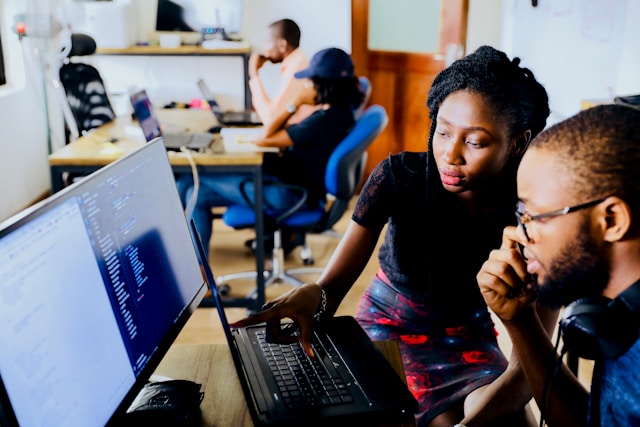Debunking the “AI Bubble” Myth for Corporate Learning
Every few days, a new headline warns that artificial intelligence (AI) is a bubble. One recent MIT study argued investing heavily in AI may see little return, pointing to wasted budgets. And for big corporations spending billions on experimental moonshots, that critique may be the case.
But here’s the truth: small businesses aren’t Google or Meta. They don’t need billion-dollar AI labs. Instead, they need practical, cost-effective solutions that improve how people work, learn, and perform.
When paired with microlearning and eLearning strategies, and delivered through affordable learning management systems (LMSs) that have AI built in, AI isn’t a bubble at all. It’s a practical breakthrough. It gives small companies access to training and development tools that were once reserved only for large enterprises.
For the first time in history, a small business can run a full-fledged Learning & Development function without hiring a large team.
Why Training Has Been a Struggle for Small Businesses
Most small businesses already know the pain of training. Traditional workshops and seminars are expensive, time-consuming, and pull employees away from the work that matters most. Hiring a full L&D team, with roles like performance consultant, data analyst, and instructional designer, is simply out of reach.
And even when training is delivered, employees forget most of what they learn within days or weeks if it isn’t reinforced.
The result? Training is often viewed as a cost center rather than a driver of business growth. For many small businesses, the lack of a scalable, affordable approach has meant they either underinvest in training or rely on outdated methods that don’t truly build skills.
But here’s the good news: the old model is breaking down. AI-driven eLearning and microlearning are rewriting the rules.
Microlearning: The Foundation of Modern Training
Microlearning delivers training in short, focused lessons (usually 3–7 minutes). Instead of cramming everything into a one-time event, employees learn in small bursts that fit naturally into their workday.
Why it works:
- Easier to retain: Science shows people remember more when learning is spaced out.
- Flexible delivery: Mobile-first, anytime, anywhere.
- Just-in-time learning: Employees access exactly what they need, when they need it.
For example, instead of forcing new hires into a 3-hour onboarding session, a small company can deliver a week-long microlearning series: one short video or activity per day. Better yet, it can be deployed asynchronously through eLearning on an LMS, giving employees the flexibility to complete training on their own schedule. The result: better retention, less disruption, and more confident new hires.
This is exactly where AI steps in to supercharge the model.
AI-Powered LMSs: Leveling the Playing Field
Until recently, running a proper training program meant hiring a team of specialists:
- A performance consultant to identify gaps.
- A data scientist to analyze outcomes.
- A learning engineer to design programs.
- An instructional designer to build courses.
Large corporations could afford entire teams of specialists to design and manage training. Small businesses couldn’t. But with today’s AI-powered LMSs and authoring tools, everything is different.
Small companies can now implement a low cost LMS to personalize learning paths based on role, performance, and skills gaps, and they can quickly convert workflows, onboarding processes, and product information into training modules in hours instead of months. Courses can be built automatically with AI-assisted text, quizzes, and even video scripts, making development faster and more affordable.
Perhaps most importantly, AI enables adaptive assessments that verify whether employees have truly mastered the skills. For a small business this kind of verification is critical.
Busting the AI Bubble Narrative for Small Businesses
So is AI a bubble? For massive enterprises pouring billions into uncertain experiments, maybe. But for small businesses, the story is different.
- Low-cost LMS platforms now come with AI built in.
- Microlearning strategies make training affordable and effective.
- AI tools reduce the need for a full L&D department.
- Skills verification ties training directly to business results.
For the first time, small businesses can access the same quality of L&D that used to be exclusive to global corporations.
Where to Start: Practical Steps for Small Businesses
Making the leap into AI-powered training doesn’t have to feel overwhelming. The key is to start small, focus on what matters most, and build momentum as you go. By approaching L&D step by step, even the smallest companies can see quick wins that grow into lasting impact. Here are some practical ways to get started:
- Audit your needs. Identify the 2-3 biggest skill gaps slowing your business down.
- Pilot microlearning. Start with one workflow or one onboarding module.
- Leverage AI authoring tools. Use AI to draft quizzes, scenarios, or short lessons.
- Choose an affordable LMS. Look for platforms with AI personalization built in.
- Measure and adapt. Use AI-driven analytics to see what works and improve continuously.
By following these steps, small businesses can create a sustainable learning culture where training isn’t a one-time event but an ongoing driver of performance.
At EduPivot.io, we help small businesses harness AI and microlearning to build training programs that stick. From selecting the right LMS to creating personalized learning paths, we make it simple to launch an L&D strategy that drives results. Reach out to us today to explore next steps.






